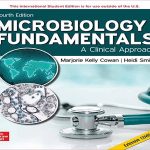- عنوان کتاب: Diagnosis of Pathogenic Microorganisms Causing Infectious Diseases
- نویسنده: Irshad M. Sulaiman
- حوزه: بیماریهای عفونی
- سال انتشار: 2022
- تعداد صفحه: 319
- زبان اصلی: انگلیسی
- نوع فایل: pdf
- حجم فایل: 10.1 مگابایت
بیماریهای عفونی بیماریهایی هستند که توسط ارگانیسمهای میکروبی بیماریزا شامل باکتریها، ویروسها، قارچها یا انگلها ایجاد میشوند. این میکروارگانیسم های عفونی پس از ورود به بدن می توانند تکثیر شوند و باعث عفونت شوند. چندین بیماری عفونی قابل انتقال شناخته شده اند که از فردی به فرد دیگر سرایت می کنند (انتقال انسان به انسان). بیماری های عفونی نیز می توانند توسط ناقلین یا از حیوانات به انسان منتقل شوند (انتقال انسان و دام). علاوه بر این، پاتوژن هایی که باعث بیماری های عفونی خفیف تا تهدید کننده زندگی می شوند می توانند از طریق هوا، آب، غذا و خاک باشند. چندین پاتوژن میکروبی جدید برای ایجاد چندین بیماری عفونی، موارد پراکنده و شیوع مرگبار در سراسر جهان ظاهر شده اند. زیستشناسی میکروارگانیسمها پیچیده است زیرا هر موجودات میکروبی منفرد (گونه/ژنوتیپ/زیر ژنوتیپ) یک اکوسیستم منحصر به فرد و یک جایگاه متمایز را اشغال میکند. علاوه بر این، مشخص شده است که گونهها و گونههای موجودات میکروبی نه تنها معمولاً با هم محدود میشوند، بلکه برای مواد مغذی و فضای محدود نیز رقابت میکنند. این محیطهای چالشبرانگیز شدید اغلب منجر به تکامل فنوتیپهای منحصربهفرد میکروارگانیسمها میشوند که میتوانند ژنوتیپ/سویه/گونه همزمان را جایگزین کنند. بنابراین، برای کنترل و پیشگیری از هر بیماری عفونی، مشخص کردن میکروارگانیسمهای شناختهشدهتر، ناشناخته/کمتر شناختهشده/کمتر، که از محیطهای بالینی، غذایی، محیطی و سایر محیطهای میکروبیولوژیکی بازیابی شدهاند، ضروری است تا زیستشناسی آشکار موجودات میکروبی و پیش بینی بهتر عملکرد میکروب های عامل بیماری های عفونی مختلف. همچنین به توسعه تکنیکهای تشخیصی قویتر برای تشخیص سریع پاتوژنهای میکروبی عفونی با اهمیت بهداشت عمومی کمک میکند. بنابراین، با توجه به حقایق فوق، این کتاب در زمینه پیشرفت هایی که در گذشته اخیر برای تشخیص انواع میکروارگانیسم های بیماری زا انسانی با اهمیت بهداشت عمومی انجام شده است، گردآوری شده است. این کتاب شامل نه فصل از متخصصان این حوزه در مورد تشخیص میکروارگانیسمهای بیماریزای زیر است که عامل بیماریهای عفونی در سراسر جهان هستند: (1) تشخیص باکتریهای گرم منفی بیماریزای انسانی (گونههای کرونوباکتر، کمپیلوباکتر)، (ii) تشخیص انسان. -باکتریهای گرم مثبت بیماریزا (لیستریا مونوسیتوژنز، استافیلوکوک)، (iii) تشخیص ویروس بیماریزای انسانی (ویروس هپاتیت B و ویروس هپاتیت C)، و (IV) تشخیص انگلهای بیماریزای دستگاه گوارش انسانی (توکسو آمبیاسیس روده، توکسو آمبیاسیس، روده، Cyclospora cayetanensis انگل کوکسیدین). این کتاب به جامعه علمی کمک می کند تا تشخیص بهتری از چندین پاتوژن میکروبی ایجاد کننده بیماری با اهمیت بهداشت عمومی را درک کند.
Infectious diseases are the sicknesses caused by the pathogenic microbial organisms that include bacteria, viruses, fungi, or parasites. These infectious microorganisms can multiply and cause an infection once they enter the body. Several infectious diseases are known to be transmissible, that spread from person-to-person (humanto-human transmission). Infectious diseases can also be transmitted by the vectors or from animals to humans (zoonotic transmission). In addition, the pathogens causing mild to life-threatening infectious diseases can be airborne, waterborne, foodborne, and soilborne. Several new microbial pathogens have emerged to cause several infectious diseases, sporadic cases, and deadly outbreaks worldwide. The biology of microorganisms is complex as every single microbial organism (species/genotype/sub genotype) occupies a unique ecosystem and a distinctive niche. Furthermore, it has been recognized that the strains and species of microbial organisms are not only typically restricted together but also compete for limited nutrients and space. These severe challenging environments frequently result in the evolution of unique phenotypes of microorganisms that can outcompete and displace the co-existing genotype/strain/species. Therefore, to control and prevent any infectious disease, it is warranted to characterize more known, as well as, unknown/little less known/less prevalent microorganisms, recovered from clinical, food, environmental, and other microbiological settings to understand the apparent biology of microbial organisms and to better predict the performance of microbes causing various infectious disease. It will also help in the development of more robust high-throughput diagnostic techniques for the rapid diagnosis of infectious microbial pathogens of public health importance. Thus, considering the above facts, this book has been compiled on the advancement that has been made in the recent past for the diagnosis of various human-pathogenic microorganisms of public health significance. This book includes nine chapters from experts in the field on the diagnosis of the following pathogenic microorganisms known to cause infectious diseases worldwide: (i) Diagnosis of Human-pathogenic Gram-Negative Bacteria (Cronobacter species, Campylobacter), (ii) Diagnosis of Human-pathogenic Gram-Positive Bacteria (Listeria monocytogenes, Staphylococcus), (iii) Diagnosis of Human-pathogenic Virus (Hepatitis B Virus and Hepatitis C Virus), and (iv) Diagnosis of Human-pathogenic Gastrointestinal Parasites (Intestinal Amebiasis, Toxoplasma gondii, Cyclospora cayetanensis Coccidian parasites). This book will help the scientific community to better understand the diagnosis of several disease-causing microbial pathogens of public health significance.
این کتاب را میتوانید بصورت رایگان از لینک زیر دانلود نمایید.
Download: Diagnosis of Pathogenic Microorganisms Causing Infectious Diseases


































نظرات کاربران